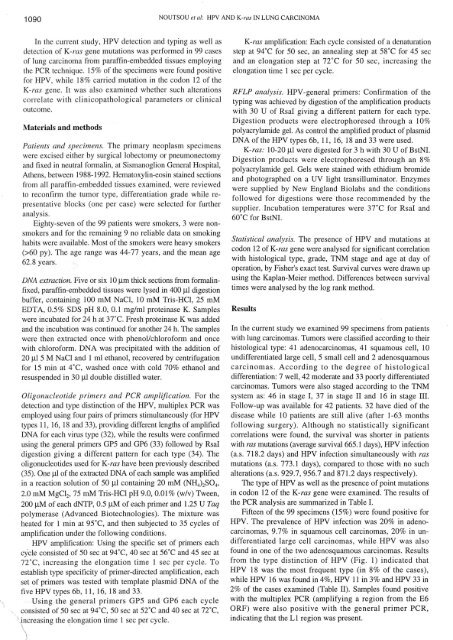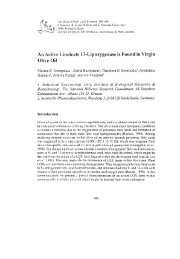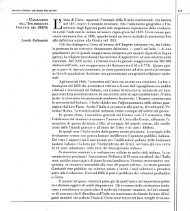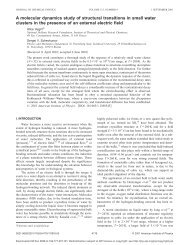Detection of human papilloma virus (HPV) and K-ras mutations in ...
Detection of human papilloma virus (HPV) and K-ras mutations in ...
Detection of human papilloma virus (HPV) and K-ras mutations in ...
You also want an ePaper? Increase the reach of your titles
YUMPU automatically turns print PDFs into web optimized ePapers that Google loves.
1090 NOUTSOU et al: <strong>HPV</strong> AND K-<strong>ras</strong> IN LUNG CARCINOMA<br />
In the current study, <strong>HPV</strong> detection <strong>and</strong> typ<strong>in</strong>g as well as<br />
detection <strong>of</strong> K-<strong>ras</strong> gene <strong>mutations</strong> was performed <strong>in</strong> 99 cases<br />
<strong>of</strong> lung carc<strong>in</strong>oma from paraff<strong>in</strong>-embedded tissues employ<strong>in</strong>g<br />
the PCR technique. 15% <strong>of</strong> the specimens were found positive<br />
for <strong>HPV</strong>, while 18% carried mutation <strong>in</strong> the codon 12 <strong>of</strong> the<br />
K-<strong>ras</strong> gene. It was also exam<strong>in</strong>ed whether such alterations<br />
correlate with cl<strong>in</strong>icopathological parameters or cl<strong>in</strong>ical<br />
outcome.<br />
Materials <strong>and</strong> methods<br />
Patients <strong>and</strong> specimens. The primary neoplasm specimens<br />
were excised either by surgical lobectomy or pneumonectomy<br />
<strong>and</strong> fixed <strong>in</strong> neutral formal<strong>in</strong>, at Sismanoglion General Hospital,<br />
Athens, between 1988-1992. Hematoxyl<strong>in</strong>-eos<strong>in</strong> sta<strong>in</strong>ed sections<br />
from all paraff<strong>in</strong>-embedded tissues exam<strong>in</strong>ed, were reviewed<br />
to reconfirm the tumor type, differentiation grade while representative<br />
blocks (one per case) were selected for further<br />
analysis.<br />
Eighty-seven <strong>of</strong> the 99 patients were smokers, 3 were nonsmokers<br />
<strong>and</strong> for the rema<strong>in</strong><strong>in</strong>g 9 no reliable data on smok<strong>in</strong>g<br />
habits were available. Most <strong>of</strong> the smokers were heavy smokers<br />
(>60 py). The age range was 44-77 years, <strong>and</strong> the mean age<br />
62.8 years.<br />
DNA extraction. Five or six 10 μηι thick sections from formal<strong>in</strong>fixed,<br />
paraff<strong>in</strong>-embedded tissues were lysed <strong>in</strong> 400 μΐ digestion<br />
buffer, conta<strong>in</strong><strong>in</strong>g 100 mM NaCl, 10 mM Tris-HCl, 25 raM<br />
EDTA, 0.5% SDS pH 8.0, 0.1 mg/ml prote<strong>in</strong>ase K. Samples<br />
were <strong>in</strong>cubated for 24 h at 37°C. Fresh prote<strong>in</strong>ase Κ was added<br />
<strong>and</strong> the <strong>in</strong>cubation was cont<strong>in</strong>ued for another 24 h. The samples<br />
were then extracted once with phenol/chlor<strong>of</strong>orm <strong>and</strong> once<br />
with chlor<strong>of</strong>orm. DNA was precipitated with the addition <strong>of</strong><br />
20 μΐ 5 M NaCl <strong>and</strong> 1 ml ethanol, recovered by centrifugation<br />
for 15 m<strong>in</strong> at 4°C, washed once with cold 70% ethanol <strong>and</strong><br />
resuspended <strong>in</strong> 30 μΐ double distilled water.<br />
Oligonucleotide primers <strong>and</strong> PCR amplification. For the<br />
detection <strong>and</strong> type dist<strong>in</strong>ction <strong>of</strong> the <strong>HPV</strong>, multiplex PCR was<br />
employed us<strong>in</strong>g four pairs <strong>of</strong> primers stimultaneously (for <strong>HPV</strong><br />
types 11, 16, 18 <strong>and</strong> 33), provid<strong>in</strong>g different lengths <strong>of</strong> amplified<br />
DNA for each <strong>virus</strong> type (32), while the results were confirmed<br />
us<strong>in</strong>g the general primers GP5 <strong>and</strong> GP6 (33) followed by Rsal<br />
digestion giv<strong>in</strong>g a different pattern for each type (34). The<br />
oligonucleotides used for K-<strong>ras</strong> have been previously described<br />
(35). One μΐ <strong>of</strong> the extracted DNA <strong>of</strong> each sample was amplified<br />
<strong>in</strong> a reaction solution <strong>of</strong> 50 μΐ conta<strong>in</strong><strong>in</strong>g 20 mM (NH 4<br />
) 2<br />
S0 4<br />
,<br />
2.0 mM MgCl 2<br />
, 75 mM Tris-HCl pH 9.0, 0.01% (w/v) Tween,<br />
200 μΜ <strong>of</strong> each dNTP, 0.5 μΜ <strong>of</strong> each primer <strong>and</strong> 1.25 U Taq<br />
polyme<strong>ras</strong>e (Advanced Biotechnologies). The mixture was<br />
heated for 1 m<strong>in</strong> at 95°C, <strong>and</strong> then subjected to 35 cycles <strong>of</strong><br />
amplification under the follow<strong>in</strong>g conditions.<br />
<strong>HPV</strong> amplification: Us<strong>in</strong>g the specific set <strong>of</strong> primers each<br />
cycle consisted <strong>of</strong> 50 sec at 94 °C, 40 sec at 56°C <strong>and</strong> 45 sec at<br />
72°C, <strong>in</strong>creas<strong>in</strong>g the elongation time 1 sec per cycle. To<br />
establish type specificity <strong>of</strong> primer-directed amplification, each<br />
set <strong>of</strong> primers was tested with template plasmid DNA <strong>of</strong> the<br />
five <strong>HPV</strong> types 6b, 11, 16, 18 <strong>and</strong> 33.<br />
Us<strong>in</strong>g the general primers GP5 <strong>and</strong> GP6 each cycle<br />
consisted <strong>of</strong> 50 sec at 94°C, 50 sec at 52°C <strong>and</strong> 40 sec at 72°C,<br />
<strong>in</strong>creas<strong>in</strong>g the elongation time 1 sec per cycle.<br />
K-<strong>ras</strong> amplification: Each cycle consisted <strong>of</strong> a denaturation<br />
step at 94°C for 50 sec, an anneal<strong>in</strong>g step at 58°C for 45 sec<br />
<strong>and</strong> an elongation step at 72°C for 50 sec, <strong>in</strong>creas<strong>in</strong>g the<br />
elongation time 1 sec per cycle.<br />
RFLP analysis. <strong>HPV</strong>-general primers: Confirmation <strong>of</strong> the<br />
typ<strong>in</strong>g was achieved by digestion <strong>of</strong> the amplification products<br />
with 30 U <strong>of</strong> Rsal giv<strong>in</strong>g a different pattern for each type.<br />
Digestion products were electrophoresed through a 10%<br />
Polyacrylamide gel. As control the amplified product <strong>of</strong> plasmid<br />
DNA <strong>of</strong> the <strong>HPV</strong> types 6b, 11, 16, 18 <strong>and</strong> 33 were used.<br />
K-<strong>ras</strong>; 10-20 μΐ were digested for 3 h with 30 U <strong>of</strong> BstNI.<br />
Digestion products were electrophoresed through an 8%<br />
Polyacrylamide gel. Gels were sta<strong>in</strong>ed with ethidium bromide<br />
<strong>and</strong> photographed on a UV light transillum<strong>in</strong>ator. Enzymes<br />
were supplied by New Engl<strong>and</strong> Biolabs <strong>and</strong> the conditions<br />
followed for digestions were those recommended by the<br />
supplier. Incubation temperatures were 37°C for Rsal <strong>and</strong><br />
60°C for BstNI.<br />
Statistical analysis. The presence <strong>of</strong> <strong>HPV</strong> <strong>and</strong> <strong>mutations</strong> at<br />
codon 12 <strong>of</strong> K-<strong>ras</strong> gene were analysed for significant correlation<br />
with histological type, grade, TNM stage <strong>and</strong> age at day <strong>of</strong><br />
operation, by Fisher's exact test. Survival curves were drawn up<br />
us<strong>in</strong>g the Kaplan-Meier method. Differences between survival<br />
times were analysed by the log rank method.<br />
Results<br />
In the current study we exam<strong>in</strong>ed 99 specimens from patients<br />
with lung carc<strong>in</strong>omas. Tumors were classified accord<strong>in</strong>g to their<br />
histological type: 41 adenocarc<strong>in</strong>omas, 41 squamous cell, 10<br />
undifferentiated large cell, 5 small cell <strong>and</strong> 2 adenosquamous<br />
carc<strong>in</strong>omas. Accord<strong>in</strong>g to the degree <strong>of</strong> histological<br />
differentiation: 7 well, 42 moderate <strong>and</strong> 33 poorly differentiated<br />
carc<strong>in</strong>omas. Tumors were also staged accord<strong>in</strong>g to the TNM<br />
system as: 46 <strong>in</strong> stage I, 37 <strong>in</strong> stage II <strong>and</strong> 16 <strong>in</strong> stage III.<br />
Follow-up was available for 42 patients. 32 have died <strong>of</strong> the<br />
disease while 10 patients are still alive (after 1-63 months<br />
follow<strong>in</strong>g surgery). Although no statistically significant<br />
correlations were found, the survival was shorter <strong>in</strong> patients<br />
with <strong>ras</strong> <strong>mutations</strong> (average survival 665.1 days), <strong>HPV</strong> <strong>in</strong>fection<br />
(a.s. 718.2 days) <strong>and</strong> <strong>HPV</strong> <strong>in</strong>fection simultaneously with <strong>ras</strong><br />
<strong>mutations</strong> (a.s. 773.1 days), compared to those with no such<br />
alterations (a.s. 929.7, 956.7 <strong>and</strong> 871.2 days respectively).<br />
The type <strong>of</strong> <strong>HPV</strong> as well as the presence <strong>of</strong> po<strong>in</strong>t <strong>mutations</strong><br />
<strong>in</strong> codon 12 <strong>of</strong> the K-<strong>ras</strong> gene were exam<strong>in</strong>ed. The results <strong>of</strong><br />
the PCR analysis are summarized <strong>in</strong> Table I.<br />
Fifteen <strong>of</strong> the 99 specimens (15%) were found positive for<br />
<strong>HPV</strong>. The prevalence <strong>of</strong> <strong>HPV</strong> <strong>in</strong>fection was 20% <strong>in</strong> adenocarc<strong>in</strong>omas,<br />
9.7% <strong>in</strong> squamous cell carc<strong>in</strong>omas, 20% <strong>in</strong> undifferentiated<br />
large cell carc<strong>in</strong>omas, while <strong>HPV</strong> was also<br />
found <strong>in</strong> one <strong>of</strong> the two adenosquamous carc<strong>in</strong>omas. Results<br />
from the type dist<strong>in</strong>ction <strong>of</strong> <strong>HPV</strong> (Fig. 1) <strong>in</strong>dicated that<br />
<strong>HPV</strong> 18 was the most frequent type (<strong>in</strong> 8% <strong>of</strong> the cases),<br />
while <strong>HPV</strong> 16 was found <strong>in</strong> 4%, <strong>HPV</strong> 11 <strong>in</strong> 3% <strong>and</strong> <strong>HPV</strong> 33 <strong>in</strong><br />
2% <strong>of</strong> the cases exam<strong>in</strong>ed (Table II). Samples found positive<br />
with the multiplex PCR (amplify<strong>in</strong>g a region from the E6<br />
ORF) were also positive with the general primer PCR,<br />
<strong>in</strong>dicat<strong>in</strong>g that the LI region was present.
















